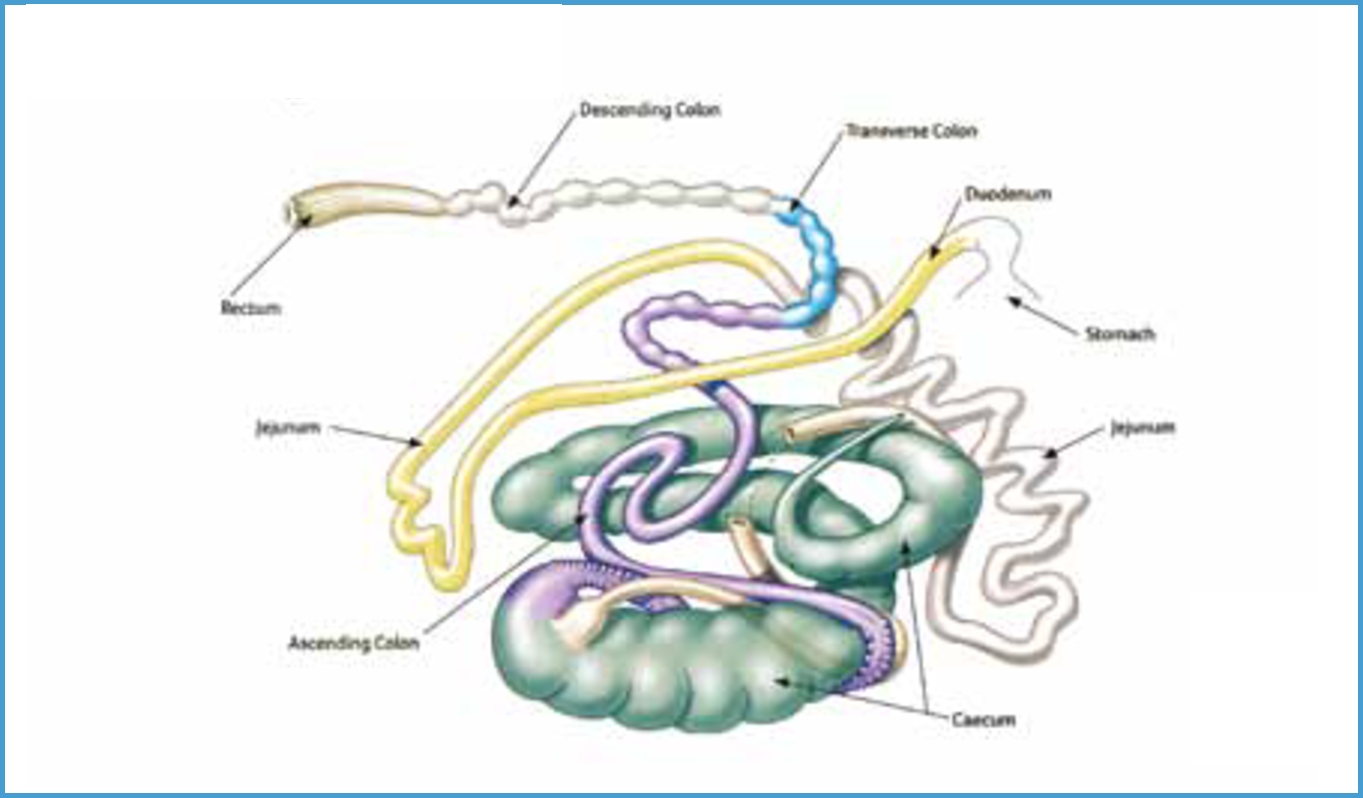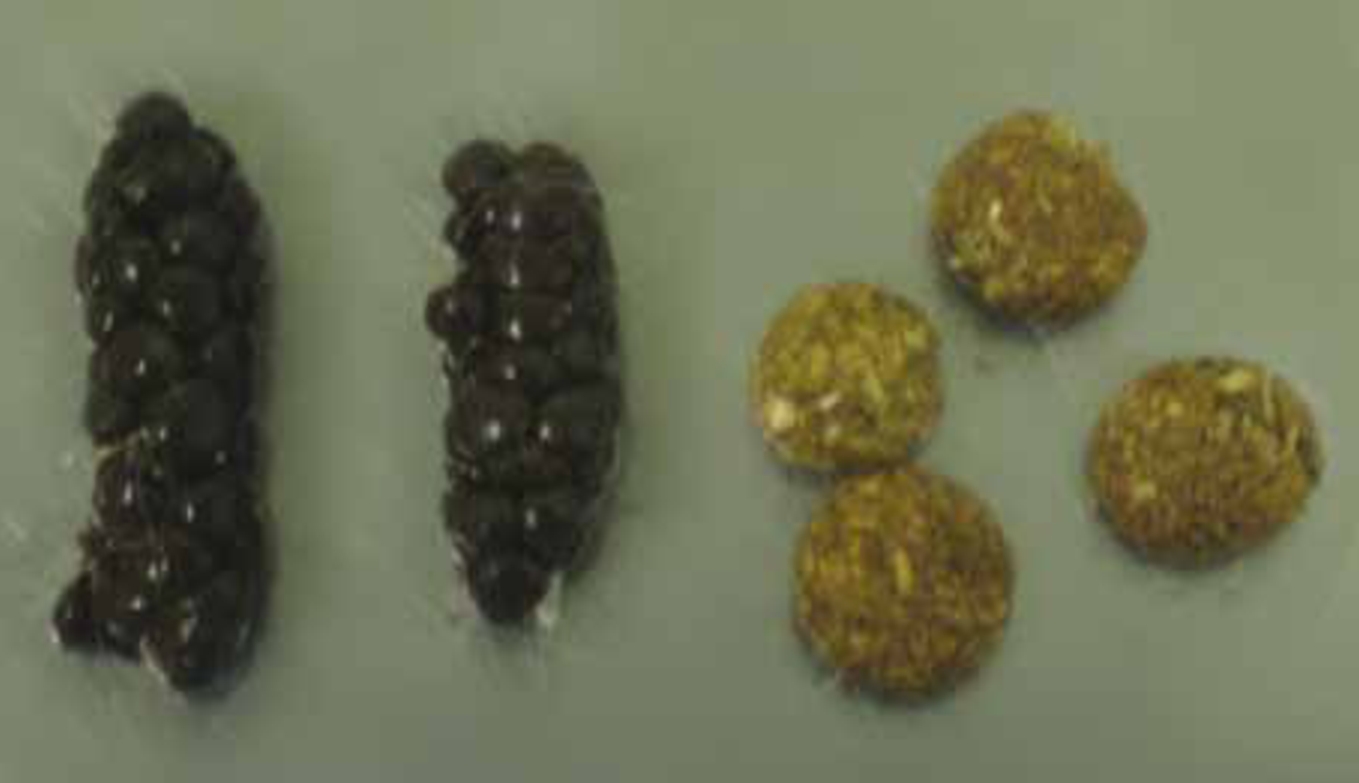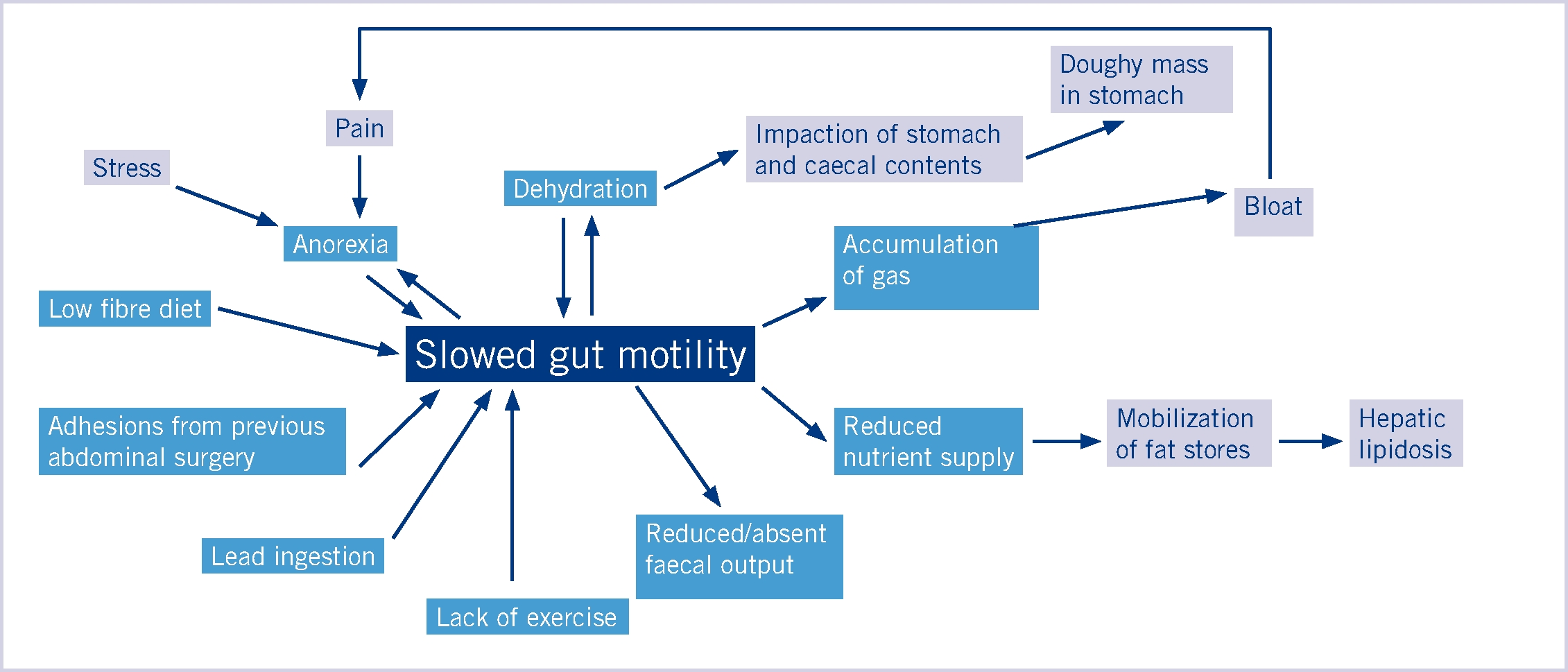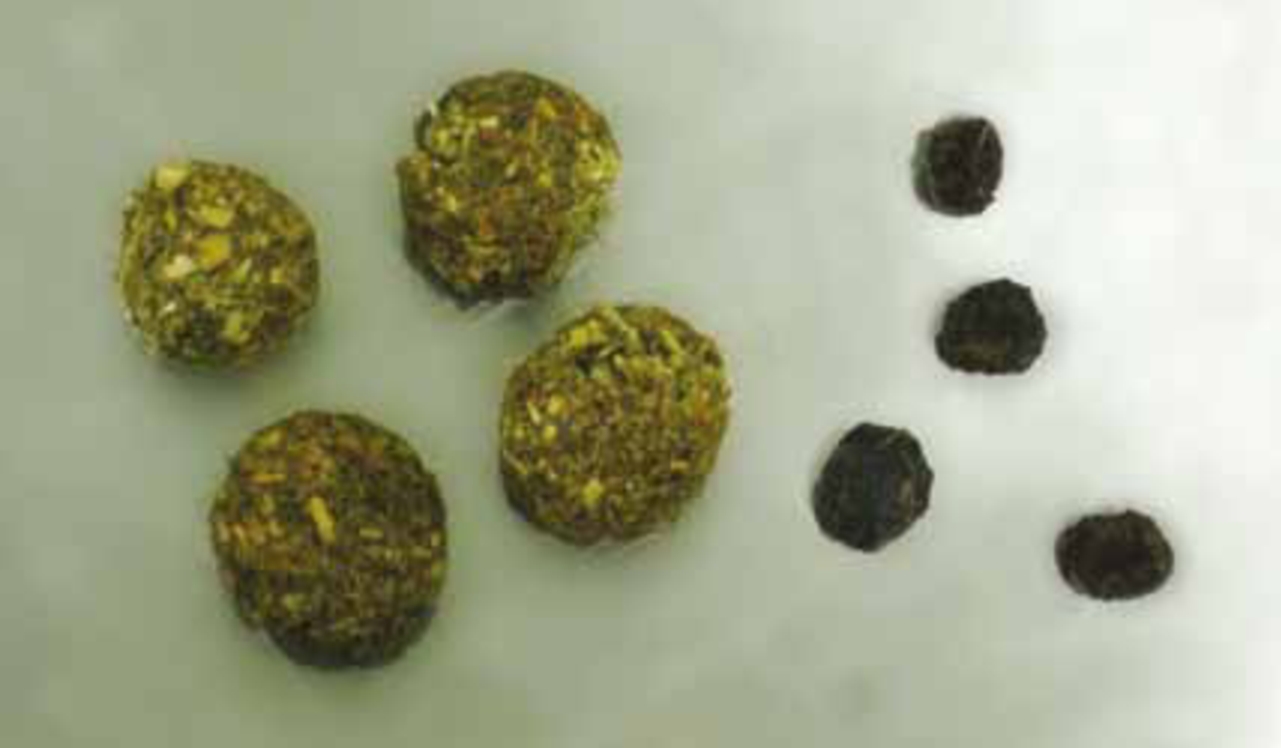Digestive conditions commonly seen in pet rabbits are different to those seen in cats and dogs. Gastrointestinal (GI) stasis is frequently encountered in pet rabbits and may be seen alone or secondary to other conditions. Rabbits suffering from any painful condition may develop GI stasis. Failure to provide supportive care during periods of anorexia can result in rapid deterioration and death, so intensive nursing of these patients is important. Good nursing practice is also essential for rabbits that are hospitalized primarily for non-digestive conditions. Routine veterinary procedures such as neutering can induce periods of anorexia leading to GI stasis. Supportive care to minimize stress and maintain food intake is essential for all hospitalized rabbits not just those initially presenting with GI stasis.
GI anatomy and physiology
Wild rabbits eat a high fibre, low energy diet of grasses and other plants. Fibre is composed of cellulose, hemicelluloses and lignin, which cannot be digested by mammalian enzymes. Fermentation by microbes (bacteria, yeasts and protozoa) within the digestive tract enables rabbits to break down digestible fibre as a source of energy. This process requires a specialized digestive tract (Figure 1).

The stomach is thin walled with a well developed cardiac sphincter that prevents vomiting. Mixing of food occurs not by muscular contraction (as in many other species) but by contractions in the adjacent large intestine and movement as the rabbit exercises (Davies, 2003). Carbohydrates, proteins and fats are digested in the small intestine as in other species.
The remaining ingesta, in the main part fibre, is separated in the colon. Indigestible fibre (particles >0.3 mm diameter) has little nutritional value to the rabbit and is excreted rapidly in the faecal pellets. While not acting as a source of nutrition this fibre is essential as it stimulates intestinal motility and keeps ingesta moving rapidly through the GI tract.
Digestible fibre (particles <0.3 mm diameter) that can be easily fermented is moved proximally into the caecum. Fermentation by the microbial population produces volatile fatty acids which are a source of energy for the rabbit. At periodic intervals, often in the morning, colonic motility alters and the rabbit enters the soft faeces stage. The fermented caecal contents are expelled and formed into caecotrophs (Figure 2) which pass through the colon before being ingested directly from the anus. They then pass through the digestive tract a second time. The microbes within caecotrophs produce vitamins B and K and contain microbial proteins which can be digested by the rabbit. This process, known as caecotrophy allows rabbits to get maximum nutrition from their diet.

Digestive diseases
Digestive diseases in rabbits are frequently caused by the interaction of several factors including diet, stress, pain and husbandry (Figure 3). GI stasis is often diagnosed but must be distinguished from intestinal obstruction as treatment differs and treatments indicated for GI stasis are contraindicated if an obstruction is present.

Other conditions not covered in this article include mucoid enteropathy, enteritis, clostridial enterotox aemia, failure to consume caecotrophs and neoplasia. Often the initial presenting sign of any digestive condition is a reduced food intake. As rabbits with GI stasis can deteriorate rapidly any rabbit with reduced food intake should be seen as an emergency, even if the rabbit is still bright.
GI stasis
GI stasis can occur in rabbits of any age, breed and sex. It is characterized by reduced or absent motility of the stomach and intestines resulting in reduced food movement through the intestines. If the rabbit becomes dehydrated water is drawn from the gut contents resulting in the formation of a firm impacted mass of food and hair in the stomach (trichobezoar). Gas builds up in the intestines resulting in pain. The reduced supply of energy from food leads to mobilization of fat from stores within the body leading to hepatic lipidosis and death.
There are many potential causes of GI stasis (Davies, 2006; Harcourt-Brown, 2002; Saunders and Davies, 2005) including:
Indigestible fibre is essential for maintaining the motility of rabbit intestines and if fibre intake ceases due to anorexia, GI stasis will rapidly develop. A vicious cycle then develops, because stasis also causes worsening anorexia and further deterioration.
Clinical signs
As a prey species rabbits hide illness so initial signs of stasis are subtle and often missed. In the early stages affected rabbits remain bright with reduction in food intake, hiding and decreased activity being the only visible signs of illness. As the disease progresses (hours to weeks) rabbits become increasingly depressed and food intake continues to fall until the rabbit is anorexic. Faecal output is reduced and is characterized by small, dark pellets (Figure 4). Faecal production can cease completely (Davies, 2006).

Diagnosis
A history of depression and a gradual reduction in food intake are suggestive of GI stasis. The stomach may feel firm and doughy as its contents become dehydrated. The abdomen may be distended and tympanic as a result of accumulating gas. Radiography is useful to distinguish advanced stasis from obstruction. Increased gas may be seen within the intestines and caecum. A ring or ‘halo’ of gas may be visible around the stomach contents (Saunders and Davies, 2005). Other tests may be needed to look for other underlying problems including dental disease, uterine adenocarcina and urinary tract disease.
Treatment
Fluid therapy
Rabbits with GI stasis rapidly become dehydrated and benefit from fluid therapy. Intravenous fluids are preferable to subcutaneous or oral administration although these can be useful in mild cases being managed at home. Oral fluids can be given by owners using the technique described below for syringe feeding.
Rabbits have a higher maintenance requirement than cats and dogs (80–100 ml/kg/24 hours). The marginal ear vein is most frequently used for placement of intravenous catheters as it is easy to access. The cephalic and saphenous veins can also be used. Elizabethan collars can be used to prevent the rabbit chewing through giving sets, however as they prevent caecotrophy and increase stress they should only be used if necessary. Shock rate fluids (100 ml/kg over 60 minutes) may be required initially (Brown and Goodman, 2006).
Diet
Rabbits develop hepatic lipidosis during periods of anorexia making nutritional support essential. Fibre stimulates intestinal motility and providing a high fibre diet will aid recovery. A variety of greens, good quality hay and the rabbit’s normal diet should be offered. Fresh grass can be offered if it is available. Lawnmower clippings should be avoided as they ferment rapidly and can cause digestive disturbance (Meredith, 2006).
Anorexic rabbits can be syringe fed high fibre recovery diets or soaked rabbit pellets (these are more difficult to syringe as larger fibre particles block the syringe). The recommended daily amount should be split into 4–6 meals per day as the stomach is poorly distensible. The frequency of feeding can be reduced once the rabbit begins to eat.
Syringe feeding is contraindicated in rabbits that are too weak to swallow or that hold their head upright; in these cases a nasogastric feeding tube can be placed. Cooperative or weak rabbits will tolerate placement while conscious but many require sedation. Radiography following placement is recommended to ensure correct placement before it is used. Nasogastric tubes can be well tolerated and where possible, Elizabethan collars should be avoided as they prevent caecotrophy and add to the rabbits stress. Nasogastric tubes should be avoided in dyspnoeic rabbits as they are obligate nasal breathers.
How to syringe feed
Feeding the rabbit with it sitting on the floor may be preferable to reduce stress and prevent injury if the rabbit attempts to jump away. Uncooperative rabbits can be wrapped in a towel to aid restraint. The nozzle of the syringe is gently inserted into the rabbit’s mouth behind the incisors and directed towards the back of the mouth. Feeding should be done slowly, allowing the rabbit to swallow between mouthfuls. Feeding too quickly can result in aspiration of food. It is also important to ensure the rabbit’s head is parallel and not raised up as this increases the risk of aspiration pneumonia from the inhalation of food (Ward, 2006).
Analgesia
Distension of the intestines is painful and many rabbits presenting with stasis will have other painful conditions (e.g. dental disease, arthritis and urinary tract disease) which have contributed to its development. Providing analgesia can encourage them to begin eating.
At presentation buprenorphine (0.03–0.05 mg/kg subcutaneously (SC) every 6–8 hours) or butorphanol (0.3–0.5 mg/kg SC/intravenously (IV) every 2–4 hours) can be used. Additional pain relief in the form of non-steroidal anti-inflammatory drugs (NSAIDs) such as meloxicam (0.2–0.6 mg/kg SC/per os (PO) every 24 hours) should only be started once dehydration and shock have been treated.
Prokinetics
Prokinetics are drugs which stimulate motility of the intestines. Examples include ranitidine (2–5 mg/kg PO every 24–28 hours), metoclopramide (0.5 mg/kg PO/SC every 8–24 hours) and cisapride (0.5 mg/kg PO twice daily (bid)). A combination of these drugs may be used in some cases.
Reducing stress
Stress slows the motility of the digestive tract and can stop rabbits eating and contributes to the development of stasis. Minimizing stress will encourage food intake and improve recovery times.
Stress can be reduced by:
Exercise
Exercise stimulates movement of food within the digestive tract of rabbits. Supervised exercise in a secure environment can be beneficial to recovery and can also promote general well being.
Monitoring
Rabbits need to be monitored closely. The tendency not to show signs of illness can make assessing changes in condition challenging. Regular assessment is essential and should include:
Obstructive ileus
Obstructive Ileus usually occurs following ingestion of foreign bodies including matts of hair, carpet, plastic, faecal pellets or food items (e.g. locust bean seeds). GI stasis can result in a dehydrated, compacted stomach mass; material can break off becoming lodged in the upper small intestine causing an obstruction.
Other causes include neoplasia, tapeworm cysts, intussception and post-surgical adhesions (Harcourt-Brown, 2007a). Fluid and gas rapidly accumulate within the stomach and intestines proximal to the obstruction, leading to acute abdominal pain, gastric tympany and hypovolaemic shock. As rabbits cannot vomit, the stomach becomes increasingly distended and can rupture (Jackson, 1991). Death occurs rapidly within 24–48 hours.
Clinical signs include:
Diagnosis of GI stasis and obstruction
A rapid onset of symptoms suggests obstruction. However similar signs can be seen in liver lobe torsion and advanced cases of GI stasis. Onset may appear sudden in some cases of GI stasis if early signs have gone unnoticed. A distended stomach and intestines up to the point of obstruction on radiography is usually diagnostic, but can be similar in appearance to later stages of GI stasis when gas builds up in the caecum and stomach. Distinguishing GI stasis and obstruction can be difficult but is important as treatments indicated for stasis are contraindicated if an obstruction is present. History, clinical examination and radiography are all useful (Table 1).
| Stasis | Obstruction | |
|---|---|---|
| Demeanour | Bright (depressed in later stages) | Depressed/collapsed |
| Appetite | Gradual reduction unless anorexia is the cause | Sudden onset |
| Faecal dropping | Gradual reduction in faecal volume and size | Rapid lack of faeces production |
| Abdominal palpation | Stomach not palpable or firm and doughy | Distended stomach |
| Radiography | Small stomach Impacted contents in stomach with gas halo Gas in caecum in later stages | Gastric dilation Distended intestines (if obstruction is within the intestine) |
Treatment
Obstructive ileus is life threatening and requires rapid treatment. Exploratory laparotomy allows visualization and treatment of the obstruction either by surgical removal or massaging it through the small intestine into the caecum (Davies, 2006). Complications include peritonitis, shock, ileus, electrolyte imbalances and renal failure (Harcourt-Brown, 2007a). Prognosis is guarded and is dependent on the time elapsed between surgery and resolution (eating normally with normal faecal output) (Davies, 2006).
Stabilization prior to surgery is essential and should include analgesia, broad spectrum antibiotics, shock rate fluids and warmth. Gastric decompression with a nasogastric tube should be attempted. Repeated attempts may be required as the tubes can block with food and fur (Harcourt-Brown, 2007b). Prokinetics (e.g. metoclopramide, ranitidine) and syringe feeding are contraindicated prior to surgery as they may cause intestinal rupture (Harcourt-Brown, 2002). Following surgery the rabbit’s treatment is similar to that given for stasis with the addition of antibiotics and appropriate wound care.
Conclusion
GI stasis is common in pet rabbits and left untreated can prove fatal. Nurses play a vital role in recovery by providing supportive care not only to rabbits hospitalized for GI stasis but through vigilance, preventing its development in rabbits hospitalized for other reasons. Obstructions can also present and can be difficult to distinguish from GI stasis. Accurate diagnosis is essential to ensure correct treatment is given. Nurses also play a role in educating clients about good rabbit husbandry, which can help prevent GI stasis occurring.
